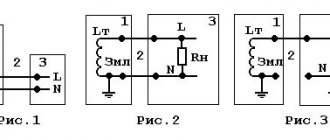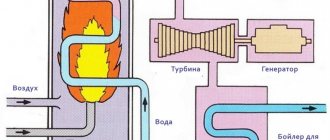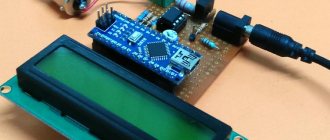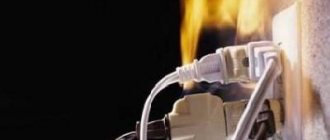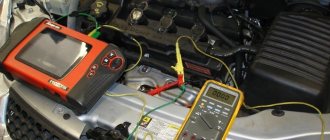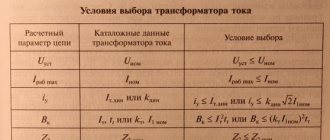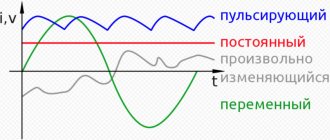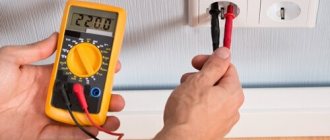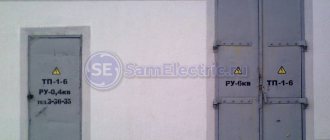Varieties of socket and plug standards
Countries around the world use thirteen different plug and socket standards. The number of elements depends on the difference in current and voltage in electrical networks:
| Socket type | Description | Country of use |
| A – American, without grounding | Two flat plates instead of pins. | USA, Japan |
| B – American, with grounding | There is a central ground pin. | USA, Central America, Canada |
| C – Europlug, European, without grounding | Two round pins. | Europe |
| D | Three round pins (one thick, two thin). | India, Britain |
| E – French | Three round pins (two are located on the plug, 1 is in the socket). | France |
| F – Schuko | Two round pins, reminiscent of type C, have grounding contact plates. | Europe |
| G – English, British | Three pins (two rectangular horizontal, one vertical). | UK, Singapore, Malaysia |
| H – Israeli | The old version had three flat pins located at an angle; the new pins have a round shape. | Israel |
| I – Australian | Three flat pins located at an angle. | Australia, New Zealand |
| J – Swiss | The shape of the plug is special: it differs in the location of the central pin from type F, two round pins resemble type C. | Switzerland |
| K – Danish | Resembles a French Type E socket, except for the ground pin located on the plug. | Denmark |
| L – Italian | Three round pins arranged in one row. | Italy |
| M | Reminiscent of an English socket, but the pins are thicker. | South Africa |
| N – Brazilian | Options of two standards (American and European) are combined, 2 types of connectors and plugs are used for regions with a voltage of 127.220 V. | Brazil |
American sockets and their features
Devices can be connected to various socket standards through adapters and adapters. In different countries, two socket standards are used depending on the voltage and frequency of the electric current:
- European, having a voltage of 220-240 V and a frequency of 50 Hz (types “S-M”). Has two contacts with a diameter of 4.0 -4.8 mm. The current strength in it is 3.5 A. Type C sockets are an outdated version, in place of which new ones appeared: E, F, J, K, L, used in European countries.
- American, where the frequency of the electric current is 60 Hz, the voltage is 110-127 V. The standard sockets are types A-B.
Source: linustechtips.comRose
Mains voltage
Edison's light bulb of 1879
This story began in 1878, when the whole world learned about the invention of Thomas Edison - an electric incandescent lamp with a carbon filament. Using calculations, the inventor derived the optimal voltage for lamps of this type (100 Volts). He took another 10% into account as voltage losses when moving along wires. Two years later, Edison patented direct current technology. To transmit electrical energy with a voltage of 110 V, three wires were required:
- null;
- positive;
- negative.
The working life of the incandescent lamp was 1200 hours.
By 1882, electric stations appeared in London and New York. Five years later, using Edison’s technology, electricity was generated by more than a hundred stations around the world.
American socket standard
They consist of two flat holes and a grounding pin (type B). The pins for distinguishing polarity are made of different widths. They are more like plates.
Type "A"
Receptacles are used in North and Central America and Japan, but Japanese and American receptacles differ:
- The pins of the American socket are different in width. This is done to maintain polarity. Tourists use Canadian and American connectors for American plugs, which are not compatible with Japanese sockets.
- Japanese plugs are two flat pins arranged in parallel and of the same size.
The sockets are not grounded and are intended for household electrical appliances with low power.
Type "B"
It is used in Japan, USA, Canada. It is intended for household appliances with high power. The sockets are called NEMA-15.
Countries with different types of sockets
Not all countries apply these standards, so tourists have to use adapters and transition devices. These include:
- South Africa, Lisotho, and Swazeland use the M type standard; the sockets resemble the D type used in Britain and also in India, but with thicker pins. Type D plugs are compatible with these connectors.
- Brazil N type plugs and connectors combine American and European standards at 127.220V and use 2 types of connectors.
- Israel has its own type H. The old version of the plugs has 3 flat pins. In the new version they are round. The Type C plug is compatible with the Type H connector.
- Denmark as well as Greenland use type K sockets, with which CEE7/7 and CEE 7/4 plugs are compatible. It resembles the French type F, except for the ground pin located on the plug.
- In the UK, Malaysia, Jordan, Malta, Cyprus, Hong Kong, Singapore, the British type G is used with a current of 32 A with three pins, one vertical, two horizontal rectangular). When visiting these countries, tourists use adapters.
- Type D sockets are used in India, Namibia, Nepal, Sri Lanka. This is an outdated British type. Their current strength is 5 A. They have round pins, one of which is thick, two thin.
Source: sergeydolya.livejournal.com
Thai socket type O
Problems with the power supply to household appliances arise after arriving in foreign countries that have their own standard of sockets. One of them is Thailand, where they use sockets of types A, B, C (220 V, 50 Hz). They have 2 main types: with three and two holes.
Thai connectors have differences from European standards. Local adapters will be required. But it’s gratifying that the sockets in Thailand include:
- Chinese flat plugs;
- Some sockets may fit the plugs that are used in the CIS.
- You can use Soviet standard plugs that have thin round pins.
Type O sockets are used exclusively in Thailand. They cannot be combined with types E and F. It is grounded (16 A 220-240 V), compatible with plug types C and O.
Australian type I sockets
They are used in Australia, Fiji, New Zealand, China, Samoa, New Guinea, Kiribati, on the Cook Islands, where there are also types A and C, they have 3 or 2 pins. The third is grounding (10 A 220-240 V). Type I plugs are compatible with the connector.
Swiss type J sockets
Applicable in Switzerland, Rwanda, Liechtenstein. They have 3 contacts, grounding (10 A 220-240 V). J and C plugs are compatible with the connector.
Italian sockets type L
Used in Chile and Italy, has 3 contacts, grounding (10 A and 16 A 220-240 V). 10 A sockets are compatible with L and C plugs. 16 A sockets are compatible with L sockets.
The world of sockets: how to charge gadgets in different countries of the world
As soon as the first craftsmen were able to light a light bulb, we began to be enveloped on all sides by networks of wires, covering buildings, streets, cities and countries, causing many related problems. Hanging wires spoil the appearance of the city and can pose a serious danger. At home, you can’t breathe a sigh of relief when there’s a tangle of twisted wires hiding under the table. And the number of energy consumers is growing at an alarming rate.
Many people have tried to rid the world of numerous high-voltage lines. There is no need to remind you of the experiments of Nikola Tesla, who in practice demonstrated the possibility of wireless transmission of electricity from a generator to a consumer. A century has passed, but the power lines are still here, just like the socket, yearning for a plug. Since the time of Tesla, all innovations in this area have had great difficulty finding their way to the consumer.
Every traveler has experienced the inconvenience of wired energy transmission. Many countries around the world use different standards for electrical plugs and sockets, which is something you need to remember when going on a long journey.
Why is the world so different
When the conversation turns to something as trivial as recharging electrical appliances, you can forget about globalization. This hamburger remains a hamburger everywhere, but the outlet mutates. Even within the EU you can find different electrical outlets. The problem is long-standing, has no clear solution, and forces tourists to replenish their luggage with a network adapter and converter.
But the type of outlet is only half the problem. You need to pay attention to the voltage in the power grid of a particular country. It’s better not to check what will happen if a device operating from 100-127 V is plugged into a socket with 220-240 V. Although we are much more interested in the opposite situation. But even if you are sure that the country where you are going has adopted the 220 volt (50 hertz) standard, it is too early to relax. Practice shows that, for example, in India, the voltage can jump from 100 to 300 volts.
There are two main voltage and frequency standards most common in the world: American - 100-127 Volt 60 Hertz and European - 220-240 Volt 50 Hertz. However, there are unique and transitional standards. And in some countries there are no standards at all.
There are several reasons for this situation.
Firstly
, the struggle of technology left its mark at the dawn of the development of electricity. We are talking about the confrontation between Thomas Edison and Nikola Tesla in the creation of DC and AC networks, respectively. Although we know that AC power plants ultimately won out, the DC infrastructure built in the US up until the 1920s (and in Stockholm into the 1950s) has to be maintained and used right up to the present day. .
Secondly
, many inventors offered their own versions of optimal (in their opinion) sockets. For example, in 1904, American inventor Harvey Hubbel received a patent for the first electrical outlet. By its design, it was a kind of adapter between an electric cartridge and a plug. The adapter was screwed into the socket instead of a light bulb, and some electrical appliance was connected to it.
The German engineer Albert Büttner created the “Euro socket” we know today in 1926. And the first grounded socket was created by Philippe Labre in 1927. Chaos was also added to by national companies that installed electrical networks and directly supplied electrical appliances to their customers, introducing various types of plug connectors (with complete disregard for similar foreign developments).
Third
, the variety of socket designs was influenced by manufacturing features and availability of materials. In Great Britain, due to a shortage of raw materials (in particular copper) during the Second World War, a three-pin plug with a short copper fuse was created, which allowed part of the reserves of this metal to be used for military needs. This plug spread throughout the British Empire, cementing the tradition of using a three-prong connector in many countries in Asia and Africa.
An illustrative example is Japan, which currently has two energy systems - Western and Eastern. Back in the 19th century, Europe came to an alternating current frequency of 50 Hertz, and the United States came to 60 Hz. In 1895, German-made generators were purchased for Tokyo, and a year later American generators were supplied to Osaka. Since then, the development of the Japanese energy system has followed two different paths.
Although all these reasons easily explain the lack of a unified standard, let's not forget about such a simple thing as demand. At the beginning of the 20th century, very few people traveled across borders with portable electrical appliances. Travelers simply did not have to deal with the problem of compatibility of plugs and sockets.
Rosette herbarium
In 1998, the US Department of Commerce assigned each type of sockets and plugs a designation in Latin letters. This classification is now accepted throughout the world.
Used in North and Central America and Japan. The plug consists of two flat parallel contacts, but in the Japanese version the contacts are the same size, while in the American version one is slightly wider than the other.
Used in North and Central America and Japan. They differ from type A by the presence of a grounding contact. In America, type B is very popular, but in Japan it is much less common.
Used in all European countries except Great Britain, Ireland, Cyprus and Malta. Type C is an obsolete but still used option. In Europe, types E, F, J, K and L are now actively used.
Used in India, Nepal, Namibia, Sri Lanka, and in certain areas of Great Britain and Ireland. Type D is an obsolete British-style plug that was used in its “homeland” until 1962.
Used in France, Belgium, Poland, Slovakia, Czech Republic, Tunisia and Morocco.
This type is also known as "Schuko". Used in Germany, Austria, the Netherlands, Sweden, Norway, Finland, Portugal, Spain, and Eastern European countries.
Before the collapse of the USSR, most sockets were designed for Type C plugs, with pins 0.8 mm smaller than the European type. In modern Russia (as throughout the CIS), type F sockets are becoming the main type.
Used in the UK, Ireland, Malaysia, Singapore, Hong Kong, Cyprus and Malta.
Israeli type.
Used in Australia, China, New Zealand, Papua New Guinea and Argentina. They can be either with two or three (with grounding) plugs.
Only used in Switzerland and Liechtenstein.
Only used in Denmark and Greenland.
Used only in Italy and very rarely in North African countries. South Africa and several other African countries have their own unique sockets - type M. There are several more rare types, more details about which can be found at the link: https://www.worldstandards.eu/electricity/plugs-and-sockets/#.
Traveler's baggage of knowledge
In order not to learn the entire table, just use a visual map:
We simply enter the name of the country and see the data we need on the type of outlet, voltage and frequency of alternating current. Yes, in Thailand there is such a pandemonium: there are sockets of several incompatible (or partially compatible) types in use at once.
On the “Map” tab, the distribution is presented visually.
However, even this map will not always help you. For example, in Brazil there is no national standard for electrical grid voltage. When traveling around Brazil, you may encounter electrical networks with both 127 Volt and 220 Volt voltages. The situation is similar in the Maldives.
Fortunately, most power adapters and chargers are now made to work with any standard voltage, from 100 to 240 Volts. Most problems can be solved by using universal adapters and universal power adapters, which should be purchased in advance.
But do not forget that there are many places in the world where the development of civilization “slips”—universal adapters are often not suitable for special sockets in African countries.
Is it possible to hope for a solution to the problem of sockets?
The first attempts to standardize the handling of electricity were made in the early 1930s.
The international standard for the universal plug was created in the 1970s, but there are hundreds of millions of sockets around the world that would be costly to replace. Steps to merge standards are still being taken today, but it is difficult to predict when this process will be completed. Most likely, a solution in the future will be achieved through a universal USB connector or widespread wireless charging.
WiTricity (short for Wireless Electricity) is a wireless power transmission technology developed by the American company of the same name.
The use of American household appliances in the CIS countries
American-made household appliances are exported to the CIS and brought by travelers. To use it, you need to purchase a European standard adapter device. A US plug will not fit into a European socket. It is better for tourists to purchase an adapter at home, since their cost in America is at least $5. This is true for staying in hotels in America. A similar situation awaits Americans in Europe.
Source: Novito.ru
Transitional devices are a way out for staying in a foreign country. It will help save time, nerves and money. Your vacation will pass without unnecessary worries if, before your trip, you rely on a summary table with information about sockets, current strength and voltage in different countries of the world.
Why in America 110 Volts were changed to 127 Volt wires
In America, 110 Volts were widespread in the twentieth century, but now 127 Volt sockets are installed in modern homes. The most interesting thing is that such changes were caused not because it is better and more comfortable, but because of simple savings. After all, it was possible to save a lot of money during construction.
In fact, the wires that are designed for a 127-volt network are much thinner than others. And if you look at it from the construction stage, this is a colossal saving. That is why the decision was made to switch to another kilowatt.
